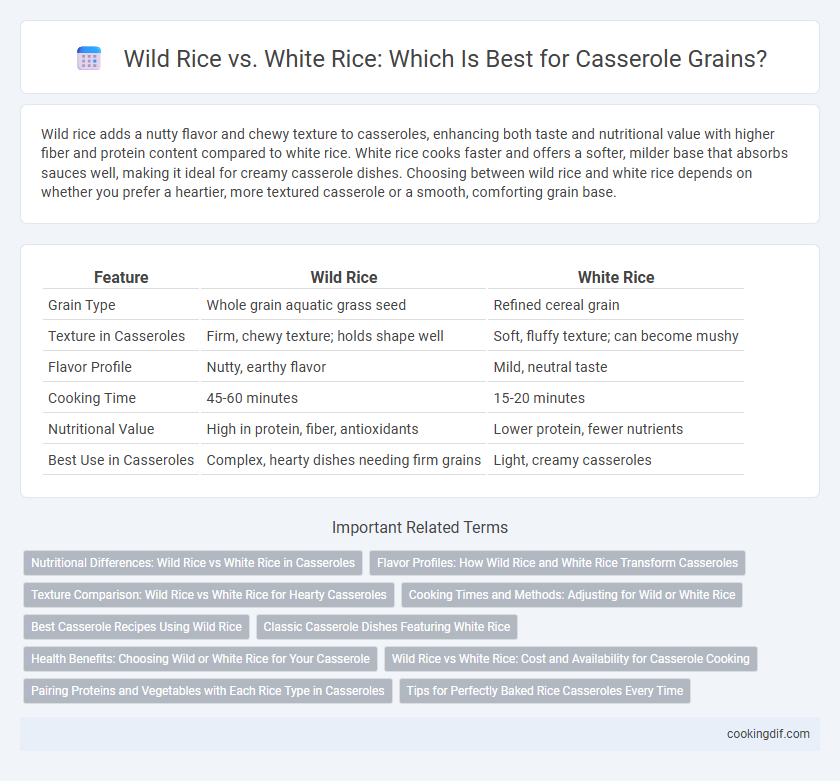Wild rice adds a nutty flavor and chewy texture to casseroles, enhancing both taste and nutritional value with higher fiber and protein content compared to white rice. White rice cooks faster and offers a softer, milder base that absorbs sauces well, making it ideal for creamy casserole dishes. Choosing between wild rice and white rice depends on whether you prefer a heartier, more textured casserole or a smooth, comforting grain base.
Table of Comparison
| Feature | Wild Rice | White Rice |
|---|---|---|
| Grain Type | Whole grain aquatic grass seed | Refined cereal grain |
| Texture in Casseroles | Firm, chewy texture; holds shape well | Soft, fluffy texture; can become mushy |
| Flavor Profile | Nutty, earthy flavor | Mild, neutral taste |
| Cooking Time | 45-60 minutes | 15-20 minutes |
| Nutritional Value | High in protein, fiber, antioxidants | Lower protein, fewer nutrients |
| Best Use in Casseroles | Complex, hearty dishes needing firm grains | Light, creamy casseroles |
Nutritional Differences: Wild Rice vs White Rice in Casseroles
Wild rice contains higher protein, fiber, and antioxidants compared to white rice, which offers primarily carbohydrates with minimal nutrients. Its robust, nutty flavor and chewy texture add complexity to casseroles, while white rice provides a mild taste and softer consistency. Choosing wild rice enhances the dish's nutritional profile, supporting better digestion and sustained energy release in casseroles.
Flavor Profiles: How Wild Rice and White Rice Transform Casseroles
Wild rice offers a nutty, earthy flavor and a chewy texture that adds depth and complexity to casseroles, making each bite more robust and textured. White rice provides a mild, slightly sweet taste with a soft, fluffy consistency that absorbs surrounding flavors, creating a harmonious and comforting dish. Choosing wild rice enhances casseroles with a distinct aroma and hearty taste, while white rice delivers a more neutral base that complements a wide range of ingredients.
Texture Comparison: Wild Rice vs White Rice for Hearty Casseroles
Wild rice offers a chewy, nutty texture that holds up well in hearty casseroles, providing a robust bite and earthy flavor. White rice has a softer, fluffier consistency that blends seamlessly with creamy ingredients, creating a smoother, more tender casserole. Choosing wild rice enhances structural integrity, while white rice emphasizes a delicate, velvety texture in casserole dishes.
Cooking Times and Methods: Adjusting for Wild or White Rice
Wild rice requires a longer cooking time, typically 45-60 minutes, compared to white rice, which cooks in about 15-20 minutes, affecting casserole preparation. To accommodate wild rice, it's best to pre-cook or soak it before combining with other ingredients, ensuring even texture and doneness. White rice can often be added directly to the casserole mixture, allowing for quicker, simpler cooking methods without pre-soaking.
Best Casserole Recipes Using Wild Rice
Wild rice offers a nutty flavor and chewy texture that enhances casseroles with a hearty, wholesome taste compared to the softer, more neutral white rice. Recipes like wild rice and mushroom casserole or wild rice with chicken and vegetables showcase its ability to absorb rich, savory sauces while maintaining distinct grain integrity. These dishes benefit from wild rice's higher fiber content and robust flavor, making it a superior choice for nutritious and flavorful casseroles.
Classic Casserole Dishes Featuring White Rice
Classic casserole dishes featuring white rice include popular recipes like chicken and rice casserole, broccoli and cheese rice bake, and tuna rice casserole, which showcase the grain's mild flavor and soft texture. White rice absorbs sauces and seasonings effectively, creating a creamy, cohesive base in casseroles compared to the nuttier, chewier wild rice. While wild rice adds a distinctive earthy flavor and firmer bite, white rice remains the preferred choice for traditional casseroles due to its ability to blend seamlessly with other ingredients and maintain a tender consistency.
Health Benefits: Choosing Wild or White Rice for Your Casserole
Wild rice contains higher protein, fiber, and antioxidants compared to white rice, supporting better digestion and heart health in casseroles. White rice offers a softer texture and faster cooking time but provides fewer nutrients and a higher glycemic index. For a nutritious casserole, wild rice is preferred for its vitamins, minerals, and complex carbohydrates that promote sustained energy release.
Wild Rice vs White Rice: Cost and Availability for Casserole Cooking
Wild rice often costs more than white rice due to its harvest complexity and seasonal availability, making it a premium choice for casserole dishes. White rice is widely available year-round in most grocery stores and offers a budget-friendly option for casseroles. The decision between wild rice and white rice depends on balancing cost constraints with desired flavor and texture profiles in casserole recipes.
Pairing Proteins and Vegetables with Each Rice Type in Casseroles
Wild rice offers a nutty flavor and chewy texture that pairs excellently with robust proteins like chicken, sausage, or beef, while complementing hearty vegetables such as mushrooms, kale, and roasted root vegetables in casseroles. White rice, with its mild taste and softer texture, harmonizes well with delicate proteins like turkey, fish, or tofu, alongside lighter vegetables like peas, carrots, and broccoli. Choosing the right rice grain enhances the overall casserole by balancing flavors and textures to match the protein and vegetable selection.
Tips for Perfectly Baked Rice Casseroles Every Time
Wild rice offers a nutty flavor and chewy texture that enhances casserole dishes, while white rice provides a softer, more neutral base that absorbs flavors well. To achieve perfectly baked rice casseroles every time, pre-cook the rice to ensure even texture and freeze excess moisture before baking to prevent sogginess. Use a tightly covered baking dish to retain steam and maintain moisture, resulting in a fluffy, tender casserole.
Wild rice vs White rice for casserole grains Infographic

 cookingdif.com
cookingdif.com